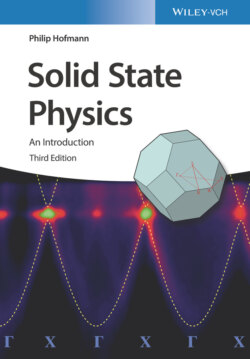Читать книгу Solid State Physics - Philip Hofmann - Страница 17
1.2.2 Close‐Packed Structures
ОглавлениеMany metals prefer structural arrangements where the atoms are packed as closely as possible. In two dimensions, the closest possible packing of atoms (i.e. spheres) is the hexagonal structure shown on the left‐hand side of Figure 1.6. To build a three‐dimensional close‐packed structure, one adds a second layer as in the middle of Figure 1.6. Now there are two possibilities, however, for adding a third layer. We can either put the atoms in the “holes” just on top of the first‐layer atoms, or we can put them into the other type of “holes.” The result are two different crystal structures. The first has an ABABAB… layer stacking sequence, the second an ABCABCABC… layer stacking sequence. Both have exactly the same packing density with the spheres filling about 74% of the total volume. The former structure is called the hexagonal close‐packed structure (hcp), and the latter turns out to be the fcc structure we already know. An alternative sketch of the hcp structure is shown in Figure 1.16b. The fcc and hcp structures are very common in elemental metals, 36 chemical elements crystallizing in hcp and 24 in fcc lattices. These structures also maximize the number of nearest neighbors for a given atom, the so‐called coordination number. For both the fcc and the hcp lattices, the coordination number is 12.
Figure 1.6 Close packing of spheres leading to the hcp and fcc structures.
It is as yet an unresolved question why not all metals crystallize in the fcc or hcp structures, if coordination is indeed so important. Whereas a prediction of the actual structure for a given element is not possible on the basis of simple arguments, we can identify some factors that play a role. For example, structures that are not optimally packed, such as the bcc structure, have a lower coordination number, but they bring the second‐nearest neighbors much closer to a given atom than in the close‐packed structures. Another important consideration is that the bonding situation is often not quite so simple, particularly in transition metals. In these, bonding is not only achieved through the delocalized s and p valence electrons as in simple metals, but also by the more localized d electrons. Bonding through the latter results in a much more directional character so that not only the close packing of the atoms is important.
The structures of many ionic solids can also be viewed as “close‐packed” in some sense. One can derive these structures by treating the ions as hard spheres that have to be packed as closely to each other as possible.
